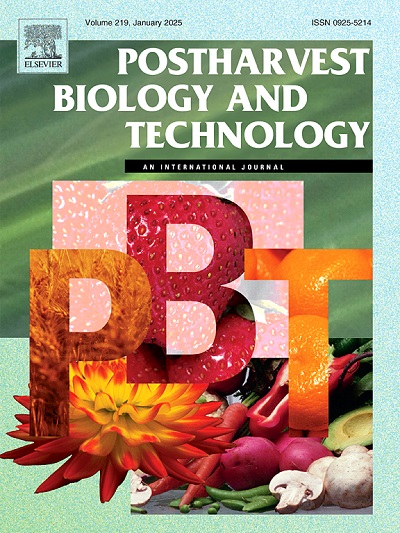The analysis of transcriptomics reveals the function of TrPLD3 in the pathogenicity of Trichothecium roseum infecting apples
IF 6.4
1区 农林科学
Q1 AGRONOMY
引用次数: 0
Abstract
Trichothecium roseum, is a casual agent responsible for postharvest disease of fruit, such as apple core rot and muskmelon pink mold, which degrades fruit quality, incurs economic losses, and produces mycotoxins threatening human health. While PLD3 of T. roseum is implicated in fungal growth and pathogenicity, its mechanism remains unclear. In this study, we investigated the function of PLD3 based on the transcriptomics during T. roseum infecting apples. The results showed that ΔTrPLD3 completely inhibited conidiation in vitro and in vivo. Furthermore, scanning electron microscope observation suggested that the hyphae of ∆TrPLD3 exhibited curvature and thinning, which hindered the growth and development of T. roseum. When PLD3 was deleted, the integrity of cell membrane was destroyed, which was manifested by the increase of cell membrane permeability, malondialdehyde content and PI staining fluorescence, and the decrease of ergosterol content. Subcellular localization confirmed PLD3 protein targeting to the plasma membrane and nucleus. The transcriptome results showed that 1072 genes were up-regulated and 1411 genes were down-regulated in ∆TrPLD3 strain. Key genes involved in the ergosterol biosynthesis pathway (ERG family), particularly CYP51, were enormously down-regulated. The conidiation-related central regulatory genes (brlA, abaA, and wetA) were nearly all silenced, and the upstream regulatory genes (fluG, flbA) and feedback regulators genes (vosA, velB) were down-regulated. Pathogenicity assays showed that ∆TrPLD3-infected apples exhibited smaller lesions in depth and ∆TrPLD3-infected tomatoes exhibited smaller lesions in area, compared to their respective WT-infected controls. Complementation restored pathogenicity. In summary, PLD3 governs pathogenicity by suppressing conidiation, disrupting ergosterol biosynthesis, and destabilizing membrane integrity in T. roseum.
转录组学分析揭示了TrPLD3在玫瑰曲霉侵染苹果致病性中的作用
玫瑰曲霉(Trichothecium roseum)是苹果果核腐病、甜瓜粉霉病等果实采后病害的偶发病原,使果实品质下降,造成经济损失,并产生威胁人体健康的真菌毒素。虽然玫瑰金霉PLD3与真菌生长和致病性有关,但其机制尚不清楚。在本研究中,我们基于转录组学研究了PLD3在玫瑰曲菌侵染苹果过程中的功能。结果表明,ΔTrPLD3在体外和体内均能完全抑制分生作用。扫描电镜观察发现,∆TrPLD3菌丝呈弯曲、变薄的特征,阻碍了玫瑰病菌的生长发育。当PLD3缺失时,细胞膜的完整性被破坏,表现为细胞膜通透性、丙二醛含量和PI染色荧光增加,麦角甾醇含量降低。亚细胞定位证实PLD3蛋白靶向质膜和细胞核。转录组结果显示,∆TrPLD3菌株有1072个基因上调,1411个基因下调。参与麦角甾醇生物合成途径的关键基因(ERG家族),特别是CYP51被大幅下调。条件相关的中心调控基因brlA、abaA、wetA几乎全部沉默,上游调控基因fluG、flbA和反馈调控基因vosA、velB下调。致病性试验表明,与wt感染的对照相比,∆trpld3感染的苹果和∆trpld3感染的番茄在深度和面积上都表现出较小的病变。补体恢复致病性。总之,PLD3通过抑制分生作用、破坏麦角甾醇生物合成和破坏玫瑰葡萄膜完整性来控制致病性。
本文章由计算机程序翻译,如有差异,请以英文原文为准。
求助全文
约1分钟内获得全文
求助全文
来源期刊

Postharvest Biology and Technology
农林科学-农艺学
CiteScore
12.00
自引率
11.40%
发文量
309
审稿时长
38 days
期刊介绍:
The journal is devoted exclusively to the publication of original papers, review articles and frontiers articles on biological and technological postharvest research. This includes the areas of postharvest storage, treatments and underpinning mechanisms, quality evaluation, packaging, handling and distribution of fresh horticultural crops including fruit, vegetables, flowers and nuts, but excluding grains, seeds and forages.
Papers reporting novel insights from fundamental and interdisciplinary research will be particularly encouraged. These disciplines include systems biology, bioinformatics, entomology, plant physiology, plant pathology, (bio)chemistry, engineering, modelling, and technologies for nondestructive testing.
Manuscripts on fresh food crops that will be further processed after postharvest storage, or on food processes beyond refrigeration, packaging and minimal processing will not be considered.
 求助内容:
求助内容: 应助结果提醒方式:
应助结果提醒方式:


